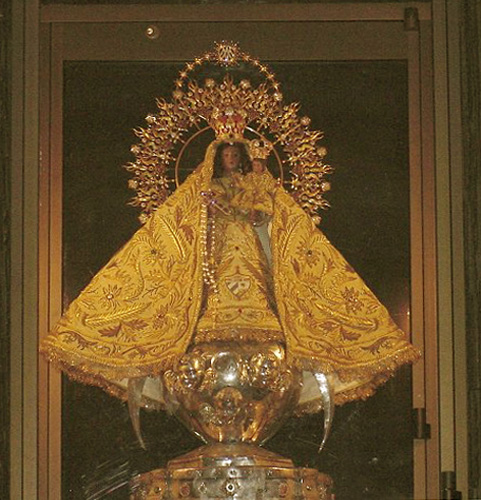Image: Adapted from Google images.
Comments: The three sources for the story of the Virgen del Cobre are (a) a report or story told by three Cubans in about 1608, (b) the story repeated orally so that it became legend retold over several generations, and (c) an official document filed in the Archivo de Indias in Sevilla, Spain, in 1687 by one of the three men, Juan Moreno, the slave of the other two men, Rodrigo and Juan de Hoyos.
The Story: The three men were looking for salt in the Bay of Nipe near Santiago de Cuba for the slaughter house in the village of Santiago del Prado. In their boat in the bay, a storm came up; the men prayed to the Virgen Mary; the storm died down; they saw an object on the water; it was the statue of a girl holding a baby (see the human faces in the statue above) in one arm and a gold cross in the other; they realized it was a statue of la Virgen María because it was dressed in real cloth, its hair was dry (even in the water), its skin was brown, and it had a board attached to it that said, in Spanish, "Yo soy la Virgen de la Caridad." The story continues: The men took the statue to a official in their town of Barajagua; he had a chapel built to house the image. Then, according to the legend, on three successive nights, the statue disappear from the locked chapel. The town's citizens then concluded that the statue (i.e., Saint Mary in Catholic tradition) wanted to be placed somewhere else, which was the nearby town of El Cobre, whose citizens were overjoyed, but the statue continued to disappear as before. When a girl named Apolonia found the statue one a hilltop in the Sierra Maestra. A shrine was then built on the hill in a region of Oriente (East Region), which was/is of great import for the Spanish colonial and national development of Cuba. The first Spanish settlement was in Baracoa in Oriente; the first capital was there at Santiago; the last Taíno chief was confined at Baracoa and burned at the stake at Yara, also in eastern Cuba; the first black slave revolt occurred in the region; José Martí launched his war of independence there; Fidel Castro launched the Cuban Revolution in that region. And, finally, Pope Benedict XVI visited the site in March, 2012.
Humanities Topic: Compare and contrast this hagiographic (story of a saint) story with the story of the Virgen de Guadalupe in México.

